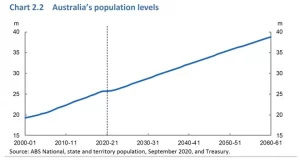Australia’s Population Forecast to HIT 38.8 million by 2060
By Leigh Martinuzzi MPG
Australia’s population is currently sitting around 25.5 million people. We have slowly grown to this number over the last 200 years since colonisation. The government 2021 Intergenerational Report (IGR) is suggesting we will see our population rise by 50% over the next 40 years, close to 40 million people. If you think we’ve got a housing crisis now what will 2060 look like?
Several issues will likely stem from such a rise in population. For example, people are expected to live longer. Males and females’ life expectancy will reach 90 years and 92 years of age respectively. This will increase our ageing population. According to the IGR, our ageing population will become more of a concern over the next 40 years. The report projects that the ratio of working-age people to those over 65 will fall from 4.0 to 2.7.
With a larger ageing population, we will have a lower labour force which in turn will reduce our productive output as a nation. The report highlights this suggesting that gross domestic product (GDP) will grow at a rate of 2.6% per year over the next 40 years compared to a growth rate on average of 3% over the past 40 years. And there are many other factors to consider, like how the effects that climate change, automation and AI, food and water shortages, and migration may impact the way we live.
What does this mean for the future of housing in Australia? I’d suppose it will mean a shift in the way we live. More high-density living is on the cards. With prices already rising beyond reasonable affordability for many, there will naturally be a shift to more condensed affordable dwelling options over the next few years. With a rising population, will be a trend over the next 40 years? I’d expect so!
The Australian dream of having a big home on a special block of land will need to adjust. Yes, more commonly now and moving forward we will see a shift in remote work arrangements however clearing and developing more of our prime farming land doesn’t make much sense. Clearing more farmlands will not help us sustain food supplies nor does this kind of activity help us manage climate change.
Housing will need to be more minimal and innovative. Dwellings will need to be more energy-efficient and we will need to consider how we can maximise the use of space to meet our basic living requirements. I believe more communal areas will need to be encouraged and adopted for more of those other activities that in low-density living arrangements will no longer be plausible. For example, sharing of sports and fitness facilities, entertainment spaces, workspaces and even eating areas.
Currently, there are 2.5 people per household in which the IGR forecasts that the average number of people per household will shrink further. This will mean that we will need an additional one house for every two houses that currently exist. Of course, the increasing trend of retirement villages and communities will help mitigate some of the issues around our ageing population, however, much more will need to be done! These are important topics for discussion to be having today.






